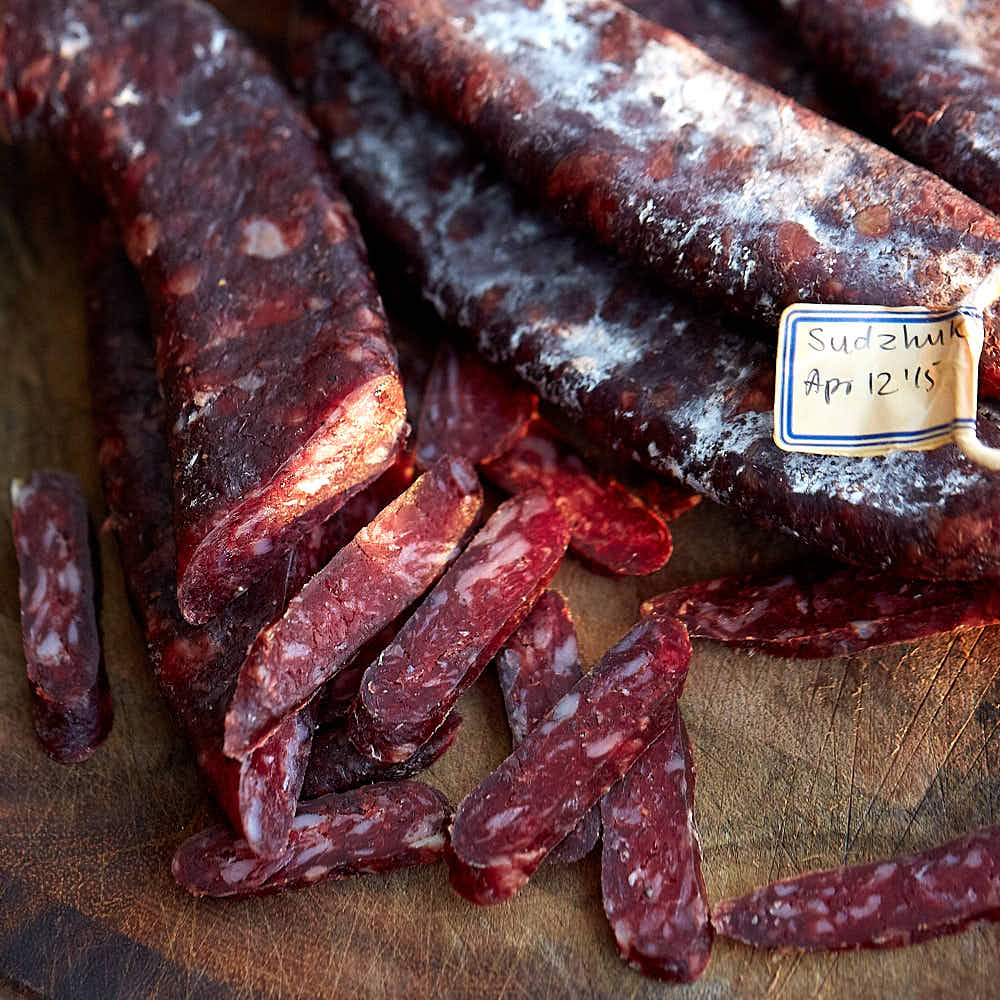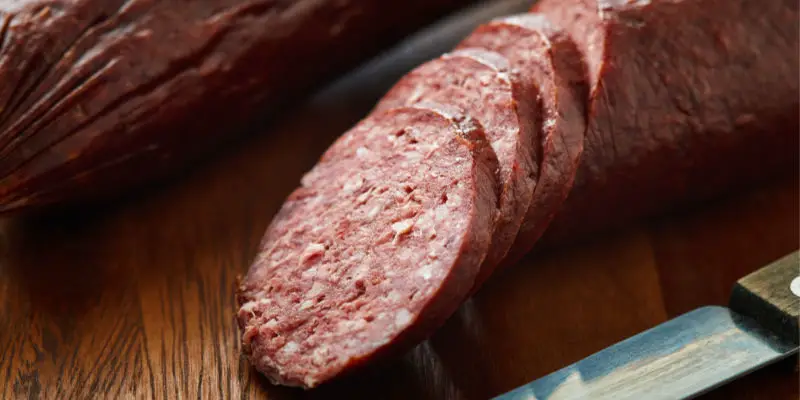Step into the realm of culinary delights with our exploration of sujuk, a delectable fermented sausage with a rich history and diverse regional variations. Embark on a culinary journey as we delve into the intricacies of sujuk preparation, uncovering the secrets to crafting this savory delicacy.
From the bustling markets of the Middle East to the vibrant streets of Central Asia, sujuk has captivated taste buds for centuries. Join us as we unravel the cultural significance of this beloved dish, tracing its origins and discovering its role in traditional cuisines.
Ingredients and Equipment

Preparing sujuk requires a careful selection of ingredients and the right equipment to ensure its distinctive flavor and texture.
The primary ingredients for sujuk are ground beef or lamb, beef fat, garlic, paprika, salt, and black pepper. Other spices, such as cumin, coriander, and allspice, can be added for additional flavor.
Equipment
The essential equipment for making sujuk includes a meat grinder, a sausage stuffer, and a drying rack or smoker.
- Meat Grinder: Used to grind the meat and fat into a fine consistency.
- Sausage Stuffer: A device that fills the sausage casings with the ground meat mixture.
- Drying Rack or Smoker: For hanging and drying the sujuk to achieve its characteristic texture and flavor.
Step-by-Step s
Crafting sujuk involves a series of meticulous steps that ensure its distinct flavor and texture. From preparing the meat to stuffing and drying, each stage requires careful attention to detail. Follow these comprehensive s to create your own delectable sujuk.
Before embarking on the journey, it’s essential to procure high-quality beef or lamb, preferably with a moderate fat content. This will contribute to the sujuk’s richness and juiciness.
Preparing the Meat
- Thoroughly wash the meat and pat it dry using paper towels. This removes excess moisture and prevents spoilage.
- Using a sharp knife, finely chop the meat into small, even-sized pieces. The size should be comparable to coarse ground beef.
- Place the chopped meat in a large bowl and generously season it with salt, pepper, and your preferred spices. Mix thoroughly to ensure even distribution.
Stuffing the Sujuk
- Prepare the sujuk casings by soaking them in warm water for at least 30 minutes. This softens the casings and makes them easier to work with.
- Using a meat grinder fitted with a sausage stuffing attachment, fill the casings with the seasoned meat mixture. Avoid overstuffing, as this can cause the casings to burst during drying.
- Tie the ends of the sujuk securely with kitchen twine or butcher’s string to prevent the meat from escaping.
Drying the Sujuk
- Hang the sujuk in a cool, dry, and well-ventilated area. Avoid direct sunlight, as this can cause the meat to spoil.
- Allow the sujuk to dry for several weeks, or until it reaches your desired consistency. The drying time will vary depending on the size and thickness of the sujuk, as well as the ambient temperature and humidity.
- Once dried, the sujuk is ready to be sliced and enjoyed. Store it in a cool, dry place for up to several months.
Variations and Regional Styles
Sujuk’s versatility extends beyond its basic ingredients, as regional variations have emerged, each boasting unique flavors and characteristics.
These regional styles reflect the diverse culinary traditions and preferences of different cultures and geographical locations.
Middle Eastern Sujuk
- In the Middle East, sujuk is typically made with a blend of beef and lamb, seasoned with cumin, paprika, and allspice.
- It has a coarse texture and a slightly smoky flavor, due to the use of dried spices and the traditional smoking process.
Turkish Sujuk
- Turkish sujuk is renowned for its intense flavor and spiciness.
- It is made with a mixture of beef, lamb, and sometimes goat meat, and seasoned generously with garlic, paprika, and red pepper flakes.
- The resulting sausage has a vibrant red color and a distinctive spicy kick.
Balkans Sujuk
- Sujuk in the Balkans region is typically made with a combination of pork and beef, and seasoned with a blend of paprika, garlic, and salt.
- It has a milder flavor compared to its Middle Eastern and Turkish counterparts, and is often smoked or air-dried.
Armenian Sujuk
- Armenian sujuk is unique in its use of apricots and walnuts.
- The dried fruit and nuts add a sweet and nutty flavor to the sausage, balancing out the spiciness of the meat.
Serving and Storage
Sujuk’s versatility extends to its serving options. It can be enjoyed as a main course, an appetizer, or a complement to other dishes. When serving as a main course, consider pairing it with grilled vegetables, rice, or flatbread for a satisfying meal.
For storage, sujuk benefits from proper techniques to maintain its quality and flavor. Vacuum-sealing or wrapping it tightly in plastic wrap prevents air exposure and prolongs its shelf life. Refrigeration keeps it fresh for up to a week, while freezing extends its preservation for several months.
Storing Vacuum-Sealed Sujuk
- Vacuum-sealing removes air, preventing oxidation and spoilage.
- Store vacuum-sealed sujuk in the refrigerator for up to 6 months or in the freezer for up to 1 year.
Storing Wrapped Sujuk
- Wrap sujuk tightly in plastic wrap to minimize air exposure.
- Place wrapped sujuk in the refrigerator for up to 3 weeks or in the freezer for up to 3 months.
Health and Nutrition
Sujuk is a high-calorie food, providing around 300 calories per 100 grams. It is a rich source of protein, with about 20 grams per 100 grams, and fat, with about 25 grams per 100 grams. Sujuk also contains significant amounts of vitamins and minerals, including iron, zinc, and B vitamins.
Health Benefits
The consumption of sujuk in moderation can provide several health benefits. The high protein content in sujuk can help build and maintain muscle mass. The iron content can help prevent anemia, and the zinc content can support immune function. Additionally, the B vitamins in sujuk can help with energy production and nerve function.
Potential Risks
Excessive consumption of sujuk can lead to several health risks. The high fat content in sujuk can increase the risk of heart disease and obesity. The high sodium content can contribute to high blood pressure. Additionally, the saturated fat in sujuk can raise cholesterol levels.
Cultural Significance

Sujuk holds significant cultural importance in various regions, reflecting its deep-rooted history and culinary traditions. Originating in the Middle East, it has become an integral part of cuisines across the globe.
Historical Origins
Sujuk’s origins can be traced back to nomadic tribes in Central Asia. It served as a portable and nutritious food source during their travels. As these tribes migrated, they introduced sujuk to different regions, where it gradually became a staple in local cuisines.
Role in Traditional Cuisines
In many cultures, sujuk is associated with festivities and celebrations. In the Middle East, it is often served during Eid al-Adha, a major Muslim holiday. In the Balkans, it is a traditional dish for Christmas and Easter. Its versatility extends to everyday meals, where it can be grilled, fried, or added to stews and soups.
Troubleshooting and Tips
While making sujuk, encountering challenges is possible. Understanding common issues and implementing practical solutions can ensure a successful preparation process.
Below are some common problems and troubleshooting tips to assist you in making delicious sujuk:
Excess Fat
- If the sujuk releases excessive fat during cooking, it indicates a high fat-to-meat ratio. To prevent this, use leaner cuts of meat and trim away any visible fat before grinding.
- Alternatively, you can soak the ground meat in cold water for 30 minutes before draining it. This process helps remove excess fat and moisture.
Dry Sujuk
- Dry sujuk can result from insufficient moisture. To address this, add more liquid, such as water, broth, or red wine, to the meat mixture. Mix thoroughly to ensure even distribution.
- Additionally, consider using a fattier cut of meat or adding some ground pork to the mixture. These ingredients will contribute moisture and prevent dryness.
Tough Sujuk
- Tough sujuk can be caused by overworking the meat mixture. Avoid mixing the ingredients excessively, as this can develop the gluten in the meat, resulting in a tough texture.
- To prevent toughness, mix the ingredients gently and only until they are combined. Overmixing should be avoided.
Spices Not Well Distributed
- Uneven distribution of spices can lead to inconsistent flavor throughout the sujuk. To ensure a harmonious blend, grind the spices finely before adding them to the meat mixture.
- Additionally, mix the ingredients thoroughly to distribute the spices evenly. This step ensures each bite of sujuk delivers a balanced flavor profile.
Additional Information
This section provides supplementary details about sujuk, including its nutritional profile, cultural significance, and additional resources for further exploration.
Preparation Time and Difficulty Level
Sujuk preparation time varies depending on the method used. Homemade sujuk typically requires several days for curing and drying, while commercially produced sujuk may be ready to eat within a few hours.
The difficulty level of making sujuk depends on the desired preparation method. Homemade sujuk requires more time and attention, while commercial sujuk is generally easier to prepare.
| Preparation Method | Time | Difficulty Level |
|---|---|---|
| Homemade | Several days | Moderate to difficult |
| Commercial | A few hours | Easy |
Serving Suggestions
Sujuk is a versatile dish that can be enjoyed in various ways. Here are some popular serving suggestions:
- Grilled or fried as a main course
- Sliced and added to salads
- Used as a topping for pizzas or pasta dishes
- Incorporated into sandwiches or wraps
Additional Resources
- Homemade Sujuk Recipe
- Turkish Sucuk: A Guide to the National Sausage
- The role of lactic acid bacteria in sucuk fermentation
Last Point
Whether you’re a seasoned culinary enthusiast or embarking on your first sujuk-making adventure, this comprehensive guide will equip you with the knowledge and techniques to create this delectable delicacy. Explore the nuances of regional variations, master the art of preparation, and discover the secrets to serving and storing sujuk for optimal flavor and enjoyment.
Questions and Answers
Is sujuk difficult to make at home?
With careful preparation and attention to detail, making sujuk at home can be a rewarding experience. Our step-by-step guide will guide you through the process, ensuring successful results.
What are the key ingredients in sujuk?
Sujuk typically consists of ground beef or lamb, seasoned with a blend of spices such as paprika, cumin, and garlic. Variations may include additional ingredients like nuts, dried fruits, or even brandy.
How long does it take to make sujuk?
The preparation time for sujuk can vary depending on the quantity being made. However, the fermentation and drying process typically takes several days to complete.
What is the best way to store sujuk?
To preserve the flavor and quality of sujuk, it should be stored in a cool, dry place with good air circulation. Vacuum sealing or refrigeration can also extend its shelf life.
